Inbound
Travel Market
Report 2025
South Korea
2025 Foreign Visitor Statistics & Market Insights in Korea
Image | Unsplash(zero take)
February 2025
Market Overview
Inbound Tourism to Korea Faces a Slowdown Despite Growth Momentum
A total of 1,138,408 foreign visitors entered Korea in February 2025, marking a 2% increase from the previous month (1,030,437) and a 10% rise year-on-year (1,031,228 in February 2024). While this appears to maintain a positive momentum, the figure remains approximately 5% below the pre-pandemic level of February 2019 (~1.2 million), indicating that a full recovery has yet to be achieved. The stagnation in the Chinese market, which traditionally accounts for a large portion of inbound tourism, has significantly limited overall growth. Despite strong performances from markets like Taiwan and the United States, they were not enough to offset this drag. Notably, even with the seasonal peak surrounding the Lunar New Year, the monthly growth rate remained below the typical average of 5%. This suggests a combination of uneven market recovery, global economic pressures, and Korea’s waning price competitiveness relative to rival destinations.Image | Unsplash(Bundo Kim)
Monthly
Annual
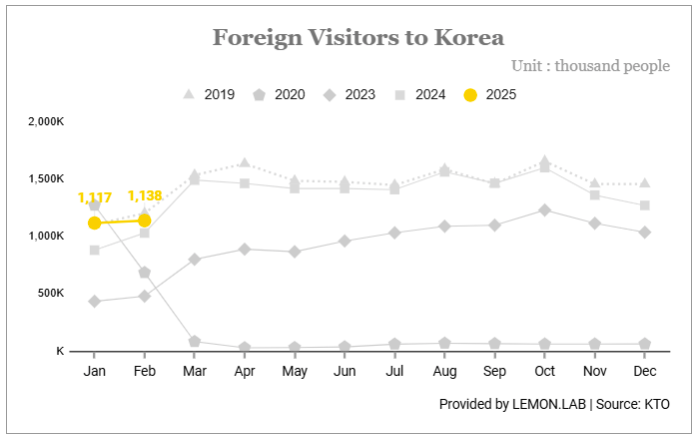
Market Highlight ①
5% Below Pre-COVID Levels:
Seasonality Effects Weakened
Entering 2025, Korea’s inbound tourism market showed a 1% growth compared to pre-COVID levels (as of January), generating cautious optimism for full recovery and further growth.
However, February saw a 5% decline compared to the same period in 2019, casting doubt on earlier expectations. Despite a 2% increase from the previous month, the growth rate fell short of the typical seasonal average of 5%, suggesting that even the Lunar New Year peak season failed to generate a strong uplift.
China continues to lag behind in recovery, remaining far below pre-pandemic levels. In contrast, Taiwan, the U.S., and Vietnam have recorded over 120% recovery compared to 2019, showing remarkable growth. Japan, in particular, saw a 17% year-on-year increase, making it one of the few markets to fully recover to pre-pandemic levels.
These markets share common drivers: continued enthusiasm for Korean pop culture and a growing preference for Free Independent Travel (FIT). As experience-driven tourism gains traction, this trend signals a structural shift from group tourism to independent travel—requiring a long-term shift in Korea’s tourism content and marketing strategies.
Market Highlight ②
Chinese-Speaking Markets Lose Momentum After January Surge
As of February 2025, the largest number of inbound visitors came from China (340,000), followed by Japan (220,000), Taiwan (120,000), and the United States (70,000).
A significant drop was observed among Chinese-speaking markets. Both China (-7%) and Hong Kong (-32%) saw notable declines compared to January, playing a major role in the overall contraction of inbound visitors in February.
In contrast, while Taiwanese visitors dropped by 11% from the previous month, they still marked a 27% increase over February 2019—setting a record high for the month.
Japan, which had shown a slight decline in January, rebounded strongly in February with a 29% month-on-month increase (220,000 visitors), representing a 5.3% rise over pre-pandemic levels.
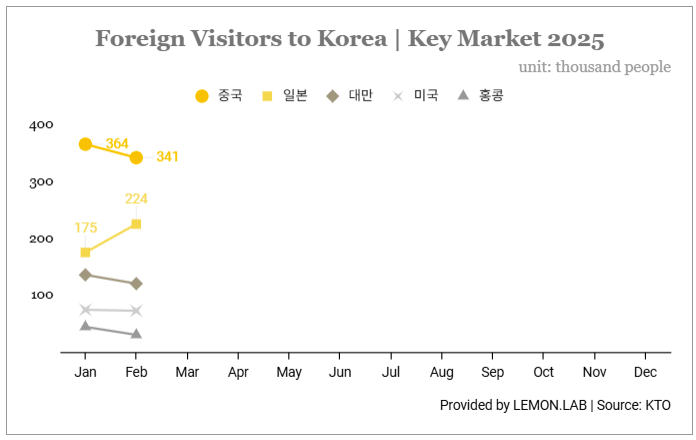
Market Highlight ③
Female Travelers in Their 20s and 30s Continue to Dominate the Inbound Market
The demographic composition of Korea’s inbound tourism market in February 2025 remained consistent with historical trends.
Female travelers accounted for 54% of all inbound visitors, outnumbering male travelers (39%).
Travelers in their 20s and 30s made up 50% of the total inbound market, highlighting the continued dominance of younger age groups.
By country of origin, China led with 30%, followed by Japan (20%), Taiwan (11%), and the United States (6%), indicating that the “Big 4” markets continue to hold a substantial share of Korea’s inbound tourism.

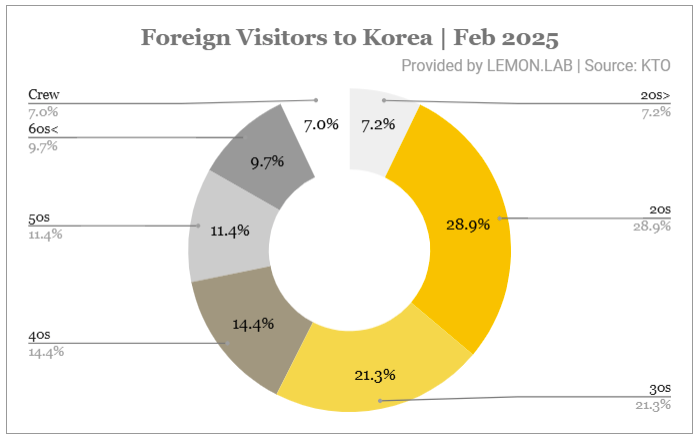
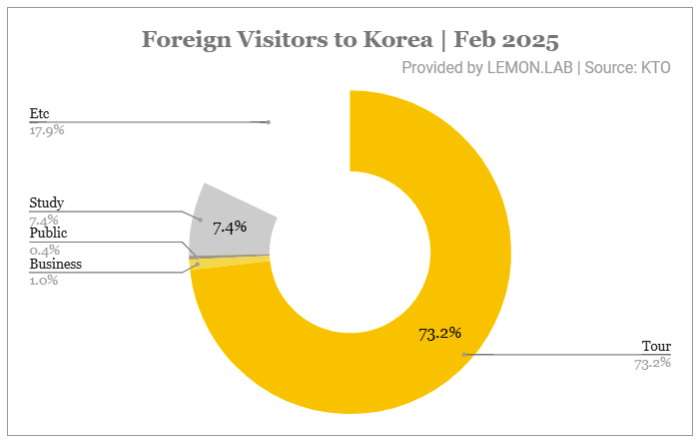
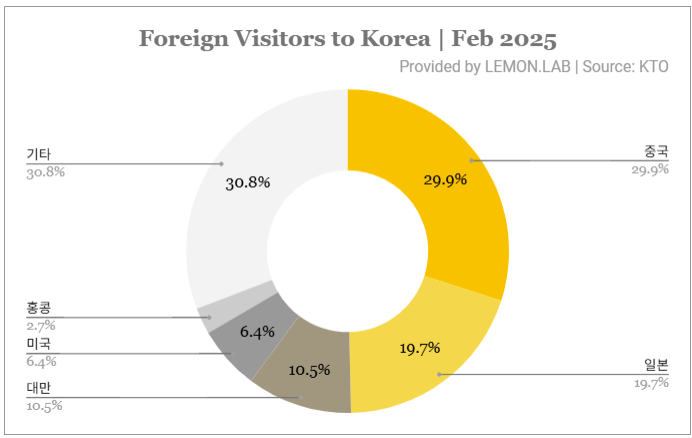

China
n February 2025, the number of Chinese visitors to Korea fell by 7% compared to the previous month.
Notably, this decline was led by a 50% drop among minors under the age of 20 and a 17% decrease among travelers in their 30s, indicating that these groups were the primary drivers of the overall downturn.
The number of Chinese visitors who came for tourism purposes dropped by 25% month-on-month, and by 7% year-on-year.
Meanwhile, the number of visitors entering for study purposes increased by 16% compared to the same month in the previous year.
This suggests that the decline in purely tourism-driven Chinese travel was even more pronounced than the overall figures indicate.
While various factors—including political and diplomatic tensions—are being cited as reasons for the decline in leisure-oriented travel from China,
a recent study revealed that Chinese travelers rated Seoul’s accommodations significantly lower than those in Tokyo.
This raises concerns that a decline in service quality targeting the Chinese market may be undermining Korea’s fundamental competitiveness as a destination for Chinese tourists.
The demographic composition of Chinese visitors remained consistent with previous trends, with females accounting for 58% and those in their 20s and 30s comprising 53%.
Due to the start of the academic year, educational travel (12%) saw a temporary rise alongside the dominant tourism segment (68%), reflecting seasonal patterns in inbound travel from China.
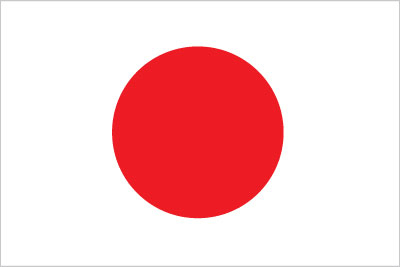
Japan
The number of Japanese visitors to Korea reached 220,000 in February, marking a 24% increase from the previous month.
This rebound offset the sharp decline seen in January, which had been triggered by political instability in Korea.
Japanese travelers are known to be particularly sensitive to safety-related issues, and past diplomatic tensions between Korea and Japan—such as disputes over Dokdo or historical grievances—have had immediate negative impacts on travel demand.
The composition of Japanese inbound travelers this month remained consistent with prior trends:
67% were female, 41% were in their 20s, and a striking 97% visited for tourism purposes.
Taiwan
The Taiwan market continued its upward trend in February, recording 120,000 visitors—the highest number ever for the month.
This achievement is particularly notable given the simultaneous downturn in other Chinese-speaking markets such as China and Hong Kong.
The composition of Taiwanese travelers remains consistent, with 64% female, 67% in their 20s, 30s, or 40s, and 98% visiting for tourism.
Notably, compared to the pre-pandemic period, growth has been observed across all age groups, indicating a broadening demographic base for inbound travel from Taiwan.

United States of America
The number of visitors from the United States reached 73,000, representing a 26% increase over February 2019 and setting a new all-time record for the month.
U.S. visitors continued to show a strong tourism focus, with 70% citing leisure as their reason for visiting.
The demographic breakdown remains highly balanced, with 46% male and 43% female, and an even age distribution:
14% in their 20s, 18% in their 30s, 14% in their 40s, 17% in their 50s, and 19% aged 60 and above.
Image | Unsplash(Anna Oliinyk)
Market Forecast
February’s statistics indicate that Korea’s inbound tourism market is steadily recovering, yet the pace of recovery remains highly uneven across source markets. The lag in recovery from the Chinese market continues to weigh on overall inbound growth, highlighting the need for targeted strategic responses.
Analyzing the trends from January and February, the inbound tourism market in Korea appears to be on a gradual path toward reaching pre-pandemic levels in the first half of 2025.
However, if core markets such as China continue to recover slowly, dependence on a handful of high-performing markets could intensify—making strategic diversification and customized marketing essential for sustainable growth.
Government Sets Target of 18.5 Million Inbound Tourists in 2025
In 2024, the number of inbound visitors to Korea reached 16.37 million, recovering to approximately 94% of the pre-pandemic level in 2019 (17.5 million).
The Korean government has unofficially set a target of 18.5 million inbound visitors for 2025, with a long-term goal of reaching 30 million by 2028.
China’s Recovery Remains the Key to 2025 Market Growth
The Ministry of Culture, Sports and Tourism previously declared 2023–2024 as the “Visit Korea Years” and announced its 6th Basic Tourism Promotion Plan, which includes a target of attracting 30 million foreign visitors by 2027.
For 2024, the government had set an official inbound tourism target of 20 million.
Although the delayed recovery of the Chinese market made it difficult to achieve the 2024 target, Japan fully returned to pre-pandemic levels, and Taiwan and the United States reached record highs.
As such, 2024 served as a pivotal year that confirmed progress in market diversification within Korea’s inbound tourism sector.
Despite the sluggish recovery of the Chinese market—which accounted for 34% of Korea’s inbound tourism in 2019—the overall inbound market made notable gains in 2024.
In 2025, Korea’s inbound tourism market is expected to fully emerge from the shadow of the pandemic and return to a path of normalization.
Encouraging signs observed in the Chinese market in January 2025 offer hope for a strong leap forward in the months to come.
This report has been prepared by LEMON.LAB Professionals™ (“LEMON.LAB”) for the purpose of providing general information, based on data collected and analyzed by our team. While every effort has been made to verify the accuracy and reliability of the information included, its completeness cannot be guaranteed.
This report is not intended to provide advice on any specific matter related to particular institutions or businesses. For decisions requiring detailed consultation, please contact the experts at LEMON.LAB.
No part of this report may be reproduced, distributed, cited, or published in whole or in part without the prior consent of LEMON.LAB.
For inquiries related to this report, please contact us at chief@lemonlab.pro.